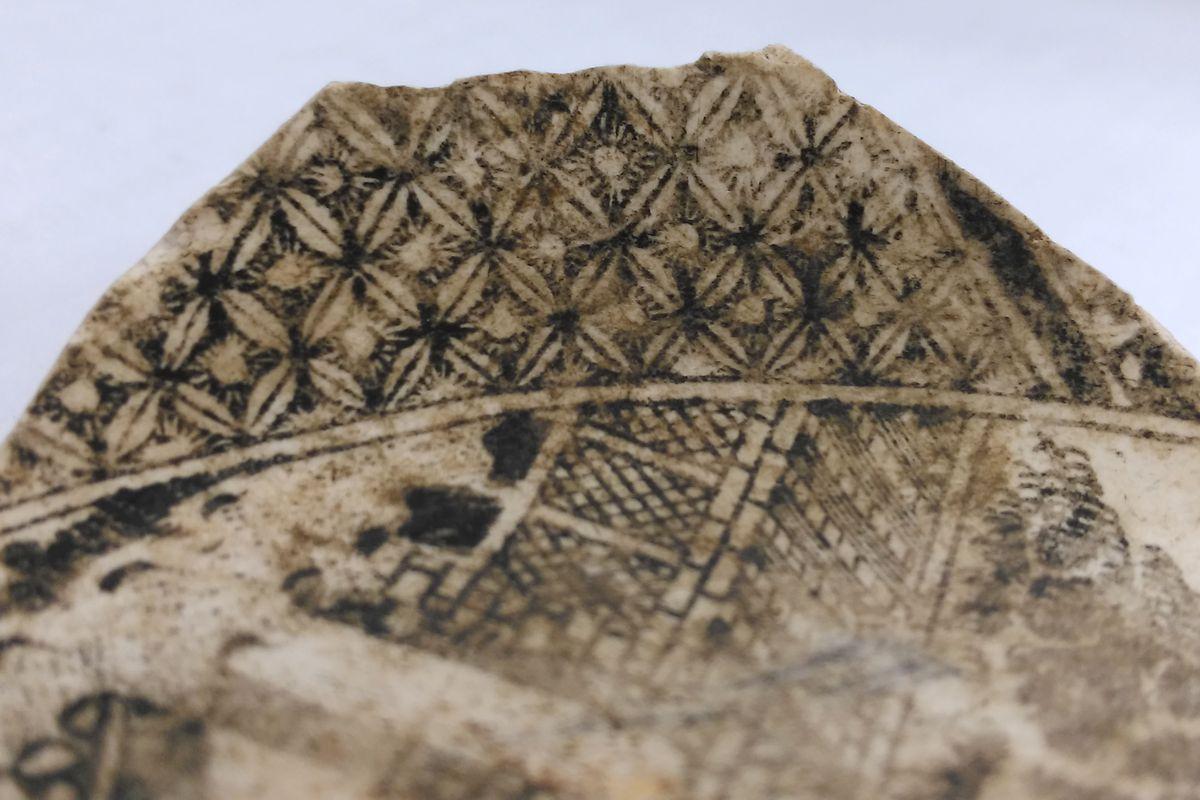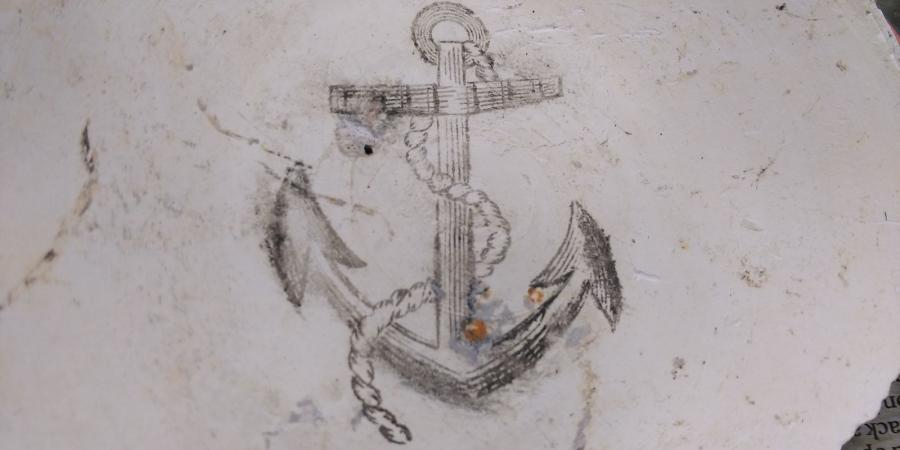Recent excavations during the construction of an extension to the rear of the Premier Inn Hotel at Lockyers Quay in Plymouth revealed not only the original quay wall, but also an interesting assemblage of locally produced Royal Navy Mess Ware. These were identified by the transfer-printed naval insignia, specifically a Foul Anchor, on the internal base of several bowls. Several sherds of the mess ware were recovered from a dump of waster material and kiln furniture which could be dated to 1825–63, but which had been redeposited as part of the later infilling and levelling of the Quayside in Plymouth.


Royal Navy Mess Ware was, as the name suggests, manufactured for use on board vessels and in institutions belonging to the Royal Navy. In the 19th century, each mess of 8–10 men had its own mess gear, comprising a dinner service for the officers and a basic kit of communal bowls and plates for the lower ranks. In the earlier part of the century, seamen were expected to supply their own mess gear, but by the late 19th century, Royal Navy victualling yards had taken charge of supply (Jarrett and Thompson 2013, 106–7; Mason 2017, 123). The bowls from the waster dump at Lockyer’s Quay would have been used by ratings and low-ranking officers if they had not been discarded as rejects.



Royal Navy Mess Ware is a relatively rare type of pottery, which is known to have been produced by a comparatively small number of companies, namely: Pountney & Co; Bovey Tracy Pottery Co.; W T Copeland & Sons; J Aynsley & Son; Worcester Royal Porcelain Company Ltd; A B Jones & Sons Ltd; Copeland & Garrett; Keeling & Co. Ltd.; Mintons; Crown Staffordshire China Co. Ltd; Chaldon Ltd; Wedgwood; Adams & Co., Hamersley & Co; and possibly F Carlidge & Co. (Pugh 1971, 91–3, 97, 99, plate 113; Jarrett and Thompson 2013, 97).
Although numerous examples are known from private and museum collections, it is relatively rare to find this type of pottery in an archaeological context. There are only two other known sites where significant quantities have been found: Royal Clarence Yard, Gosport (Jarrett and Thompson 2013), and a Pountney & Co. waster dump from Barton Hill, Bristol (Mason 2017). The discovery of a waster dump from a previously unknown manufacturer, is therefore of some significance in the study of Royal Navy supply patterns and the archaeology of Plymouth’s 19th-century ceramic industry.
There is only one likely source for the whiteware wasters from Lockyers Quay – and that is William Alsop’s pottery at The China House, which is located just 200 m to the west of the site. The China House (a Grade II Listed Building today), was constructed as a warehouse in 1650. It was subsequently used as a victualling yard and naval storehouse (1667); gun wharf (1697); naval hospital (1756); and in 1768 it was converted for use as a pottery by William Cookworthy, England’s first porcelain manufacturer (Historic England 2018). Cookworthy later moved his porcelain factory to Bristol in 1774 (Jewitt 1878, 338).
However, around 1810, William Alsop began manufacturing ‘painted, printed and enamelled Queen’s Ware’ (Pearlware) at The China House. By 1815, there were three other potteries in Plymouth, all ‘common brown and yellow earthenware’ manufacturers, based in Coxside. These potteries, run by Messrs Fllis, Algar and Hellyer, were all located adjacent to Alsop’s pottery (Jewitt 1878, 338; Bracken 1930, 8). However, by 1844, there were only two potteries surviving in Plymouth: William Alsop of the Victoria Pottery (The China House), and Josiah Hellyer of Teat’s Hill (Flintoff 1844, 90).
Alsop is the only known manufacturer of pearlware or refined white earthenware in Plymouth at this time. In 1841, Robert Alsop invented a form of ceramic infusion jar, which was later copied and manufactured by W T Copeland & Sons for use at the Royal Navy Hospital, Plymouth (Pugh 1971, 98–9). It is unknown if Robert and William Alsop were related. If they were, then this provides a potential link between with the Royal Navy during the period when Alsop’s pottery was active.
At some point after 1837, Alsop’s pottery became a Limited Liability Company. Its products were subsequently marked with the Queen’s Arms and ‘P.P. COY. L. (Plymouth Pottery Company Limited) STONE CHINA’. No sherds with these marks were recovered from Lockyer’s Quay, though a single sherd marked with a crown and ‘IMPROVED S_’ was recorded. Alsop was declared bankrupt in 1850 (The West of England Conservative, and Plymouth and Devonport Advertiser, 6 November 1850, 3), though the pottery apparently remained active under the direction of Mr Bishop, who ran the concern until its closure in 1863 (Jewitt 1878, 338).
References
Bracken, C W Plymouth pottery: evidence regarding early work, Western Morning News, 13 January 1930, British Newspaper Archive (accessed 8 May 2018)
Flintoff G 1844 Flintoff’s Directory and Guide Book to Plymouth, Devonport, Stonehouse and their Vicinities. Plymouth, G Flintoff (accessed 8 May 2018)
Historic England 2018 The China House (accessed 8 May 2018)
Jarrett, C and Thompson, G 2013 A group of early 20th-century naval victualling finds from Royal Clarence Yard, Gosport, Hampshire, Post-Medieval Archaeology, 46:1, 89-115, (accessed 4 May 2018)
Jewitt, L 1878 The Ceramic Art of Great Britain. London, Virtue and Co
Mason, C 2017 Barton Hill Pottery and the post-medieval redware industry in Bristol, Post-Medieval Archaeology, 51:1, 108–31 (accessed 4 May 2018)
Pugh, P D G Naval Ceramics. Newport, The Ceramic Book Company
